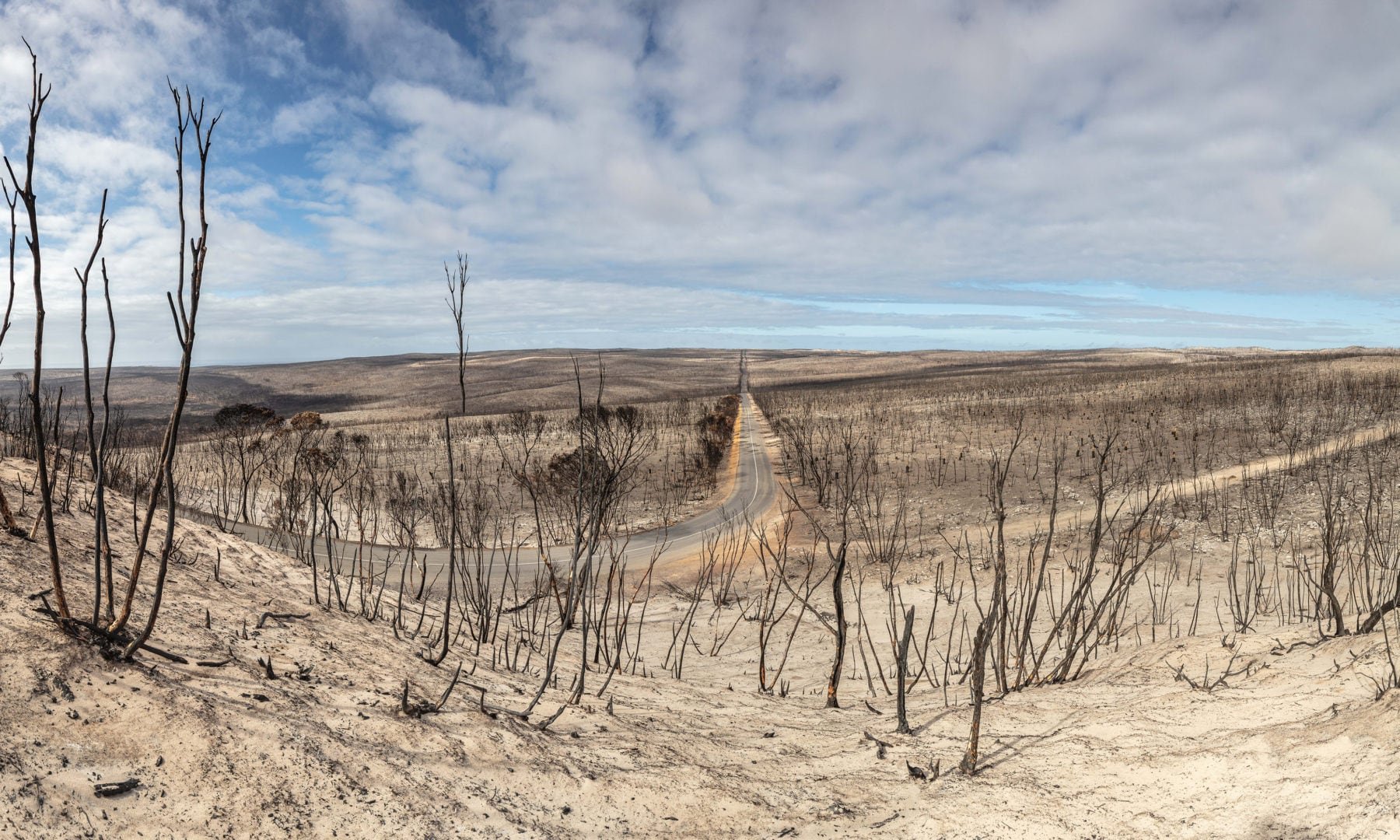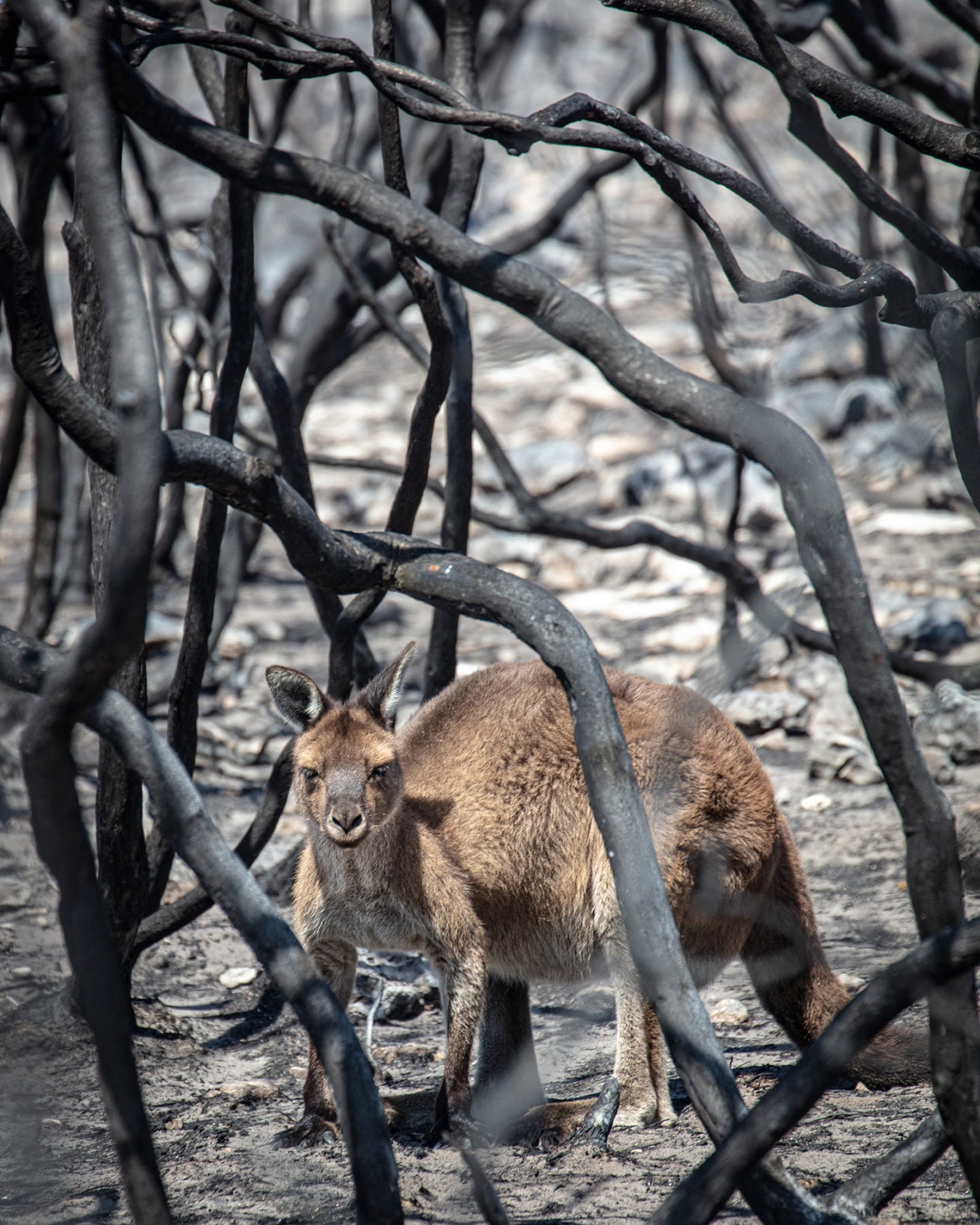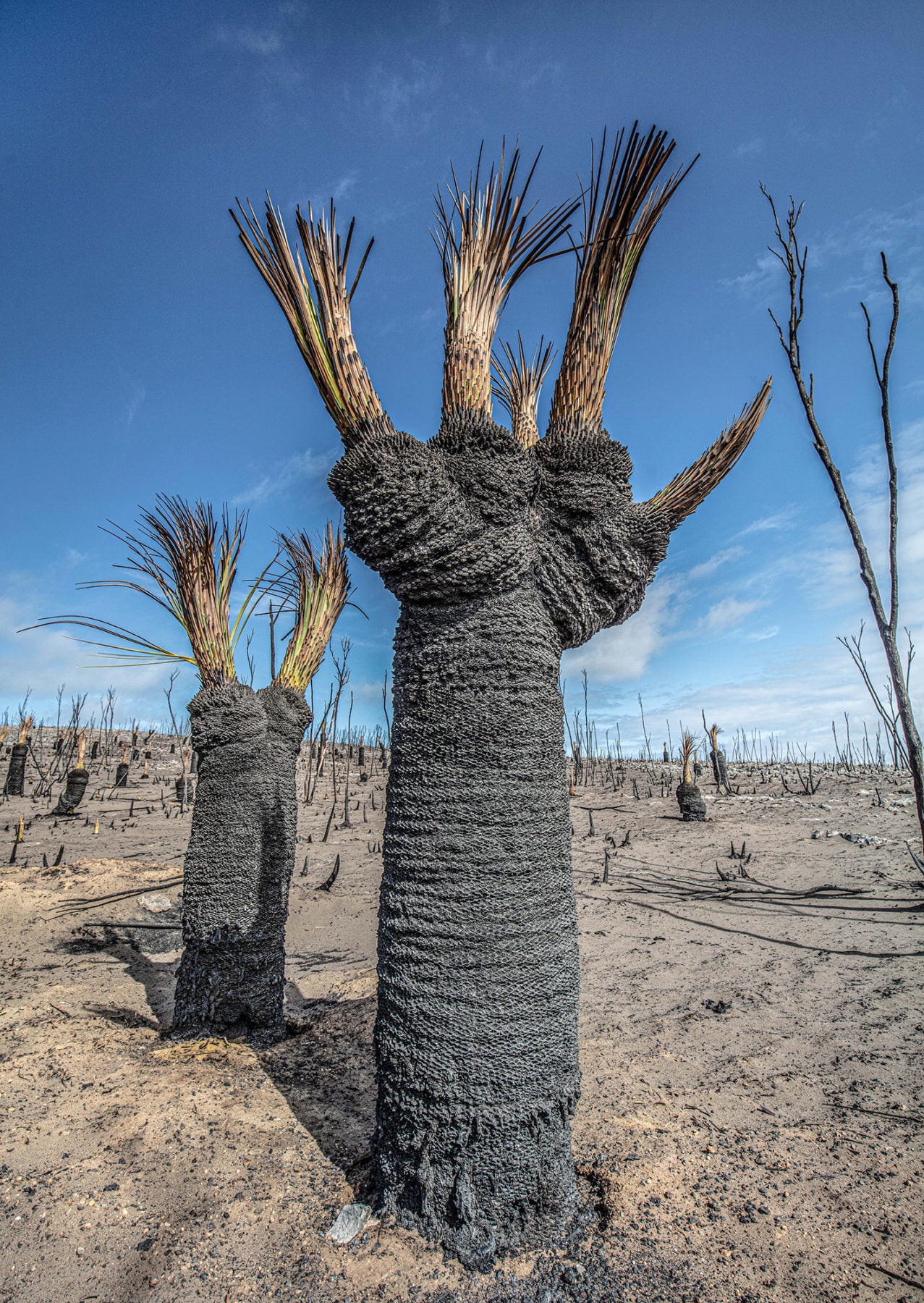VANTAGE POINTS WERE rare in Flinders Chase. The densely wooded tracks through Kangaroo Island’s beloved national park gave little away. Drive south, however, and the road curves to a lookout atop Bunker Hill.
This ancient dune crest was once a favourite spot to pull over at. Here, locals could recount a miracle of rebirth, the resurgence of an entire woodland realm following the December 2007 bushfires that tore through 85 per cent of the park.
On the last day of last year I stopped here with a German couple I was guiding around my island home. Under crisp blue skies we gazed across an undulating expanse of close-packed mallee scrub.
This lavish sea of green growth dipped and rolled all the way to the coast. Perky blue wrens skittered at our feet as I shared the park’s revival tale with my guests. Little did I know this would be my last such vision from Bunker Hill, at least for a decade or two.
Three days later a devastating inferno roared south through Flinders Chase National Park. Branded the ‘Ravine Fire’, it moved with a speed and ferocity much greater than the 2007 blaze. Just weeks earlier, islanders had celebrated the park’s centenary and the pioneering field naturalists who’d fought for nearly three decades for its creation.
More than just a refuge for plants and animals, ‘The Chase’ was cherished as a bastion of the woodland diversity and vigour long lost from mainland South Australia. In six brutal hours this priceless natural enclave was transformed into a charnel house of sticks, ash and blackened bones.
The Ravine Fire was not the end of our island’s woes; nor was it the beginning. At the onset of summer, and after two years of below-average rainfall, the island’s farms and bushland were perilously dry. A mid-December hot spell ended on the afternoon of 20 December. It was a stifling day of 42°C heat with bushfires charging through the Adelaide Hills.
By mid-afternoon a dry lightning storm was blitzing Kangaroo Island ahead of the change. Within an hour the Country Fire Service (CFS) website was showing a dozen or so separate grass fires flaring up across the island.
Anxious about our fate, I closed the laptop and drove up Cape Willoughby Road to keep a lookout for lightning strikes and smoke and passed a neighbour returning from the same mission. Mercifully, the only fire on the Dudley Peninsula, at the island’s eastern end, was quickly doused by the Penneshaw fire crew.
However, further west a crisis was unfolding. The cool change brought punchy southerly winds gusting to 80km/h. By late afternoon, fires were raging along heavily timbered ridgelines and valleys that drop steeply to the island’s north coast.
As the Christmas Pageant trundled through Kingscote beneath an eerie smoke-streaked sky, the red CFS emergency warning zone was extended to span 80km of the island’s northern hinterland.
This expanse includes some of the steepest and most inaccessible terrain in the state, none more so than at Western River. By nightfall the fires had descended onto the homestead nestled at the base of the valley where Caroline Taylor, a good friend, was home alone.
With little phone reception she turned to a Facebook group for help: “Fire all around the house: inside garden. Hills both sides ablaze. Smoke everywhere. Too dangerous for spot watering but what do I do???” After two tense hours she was courageously rescued, along with four backpackers from the nearby cove, by local CFS Captain Michael Swaine.
For a small community scattered across 4500sq.km, Facebook became the indispensable lifeline for information and news of friends during the following weeks. The go-to page was The Islander, where Stan Gorton, our local newspaper’s indefatigable editor, shared CFS alerts, along with a steady stream of timely updates from the field.
Every day, new stories surfaced of lucky escapes and grim losses, along with images from the fireground of volunteer crews and farm units doing their utmost.
Through the last week of December the initial fires continued to burn, though mostly within containment lines. Then on 30 December I was woken just before dawn by lightning. Once again, I took to the road to keep watch. And many neighbours did the same, as I later learnt.
Thankfully, the storm swept south out to sea, but not before it had sparked new fires on the island’s far western flanks, including two outbreaks deep within the remote Ravine des Casoars section of Flinders Chase.
By 2 January these fires had roiled into dense bush to the north and west, and the CFS shared grave concerns about the volatile conditions to come. Our worst fears were realised late next morning when the two Ravine blazes merged.
Driven by stiff north-easterly winds, the massive fire front pushed south into Flinders Chase. It soon overwhelmed the park’s fire crews and charged onwards to the coast at Remarkable Rocks.
I was working at Seal Bay Conservation Park that day. Even from 40km away the scale of the unfolding catastrophe was writ large across the western sky. A pyrocumulus cloud towered nearly 18km upwards. The smoke plume stretched 70km out to sea.
At 3pm we evacuated the park. The sun was streaming into the bay where sea lion pups splashed in the shallows. As I ushered the last visitors up the boardwalk, many were still wanting selfies and seemed oblivious to what was happening, as if the smoky pall hugging the horizon was nothing out of the ordinary.
With each passing hour that evening, the news grew more dire. As the winds swung to the west and south-west, they gathered strength, shunting the fires along the south coast and eastward towards Parndana in the heart of the island.
By 9.30pm the Emergency Services control centre was evacuating to the town of Kingscote and the entire island was now either under an Emergency or Watch And Act warning. It was another unnerving night of knowing too much and yet not enough.
At some point the warnings and updates became a blur. So too the picturing of places, farms and people in the fire’s path; all the homes, nest sites and hand-hewn cabins; the bush-fringed bays, the hidden streams and our sentinel trees where we looked for koalas and cockatoos; and so many dear friends living close with their animals, be they nature’s mobs or tended flocks. All of it swept into a chaos beyond comprehension.
In the Following days the punishing toll of this horrific fire was revealed. Most tragic was the loss of legendary bush pilot Dick Lang and his son, Clayton, who died trying to return to their property after two days fighting a nearby fire.
Across the island the physical destruction was overwhelming: Southern Ocean Lodge, Hanson Bay Sanctuary, Kangaroo Island Wilderness Retreat, the visitor and heritage buildings at Flinders Chase – all gone. It wasn’t just the loss of the structures; they were symbolic gateways to a cherished natural kingdom that now lay in ruins.
Through the island’s heartlands, many farm families suffered the destruction of multiple houses and much of their livestock. A friend told me his neighbour lost nearly 5000 ewes in 10 minutes. For most farmers, these flocks represented careful breeding programs spanning decades. Elsewhere, thousands of hectares of plantation forest were burnt, vineyards wiped out and scores of beehives destroyed.
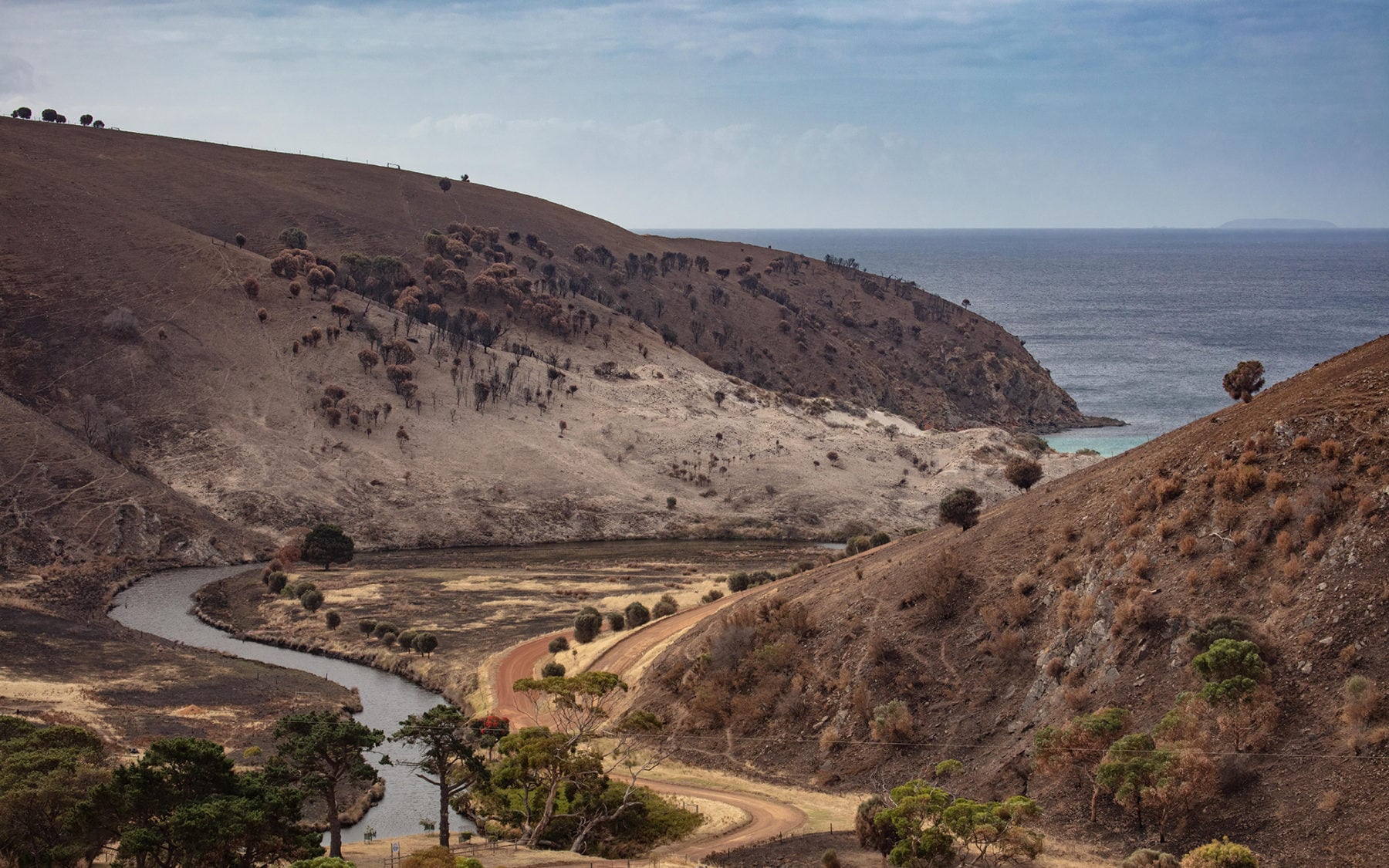
As if this wasn’t distressing enough, all through January fires kept breaking control lines, surging with the island’s mercurial winds.
It was yet another hot, ominous, blustery day on 9 January. By mid-afternoon fires had flared around Parndana and Vivonne Bay on the south coast. Then, near sundown, the wind swung and raged across the island from the south-west, driving multiple fire fronts eastwards.
Smoke and falling ash streamed east to Cape Willoughby. By midnight Kingscote was under an emergency warning. Frantic residents and evacuees, many gathered at the town wharf, faced the unthinkable as the fire’s shocking spectral glow loomed in the western sky.
Then, in the early hours of the morning, the rain came. Not much, but enough to help subdue the flames and calm the mood. So many stories from that long, sleepless night – and all the other dirty nights and days the island had endured this past summer.
No slick summary can properly give voice to the heartbreak and collective grief, the grit and big-hearted community courage of these weeks.
But if there’s a bottom line it’s that we’re still here and we’ll come back from this.
Islanders are stubbornly self-reliant folk. That’s always been the way. It’s their knack for surviving without much in the way of back-up from afar. But this summer was different. So many mainland fireys came to join the fight, then the army too, and ferry-loads of mates and strangers with food and other gear, plus all sorts of bods to help us put up fences and rescue the roos and koalas.
In their own way the waves of goodwill and generosity from around the world were overwhelming. Maybe it’s because we’re an island and people feel for our isolation. But perhaps it’s also something about how the place quietly managed to juggle its farming with caring for nature and looking after visitors.
Along with the island’s stirring wildness there has always been a bit of outback makeshift spirit here that travellers warmed to.
A couple of weeks after Flinders Chase was burnt out, my wife, Dale, and I took a drive through the park. Over the years it had become a big part of our lives, a place chock-full of discoveries, epic weather, wildlife encounters and deep-layered memories.
The initial shock as we passed through once mighty stands of sugar gum, now lying charred and broken, was almost too much to bear.
Down at Remarkable Rocks, one of the island’s most recognisable landmarks, the boardwalk was gone, the tight weave of scrub incinerated. The heat of the blaze had shattered the very granite itself at the base of the rocks.
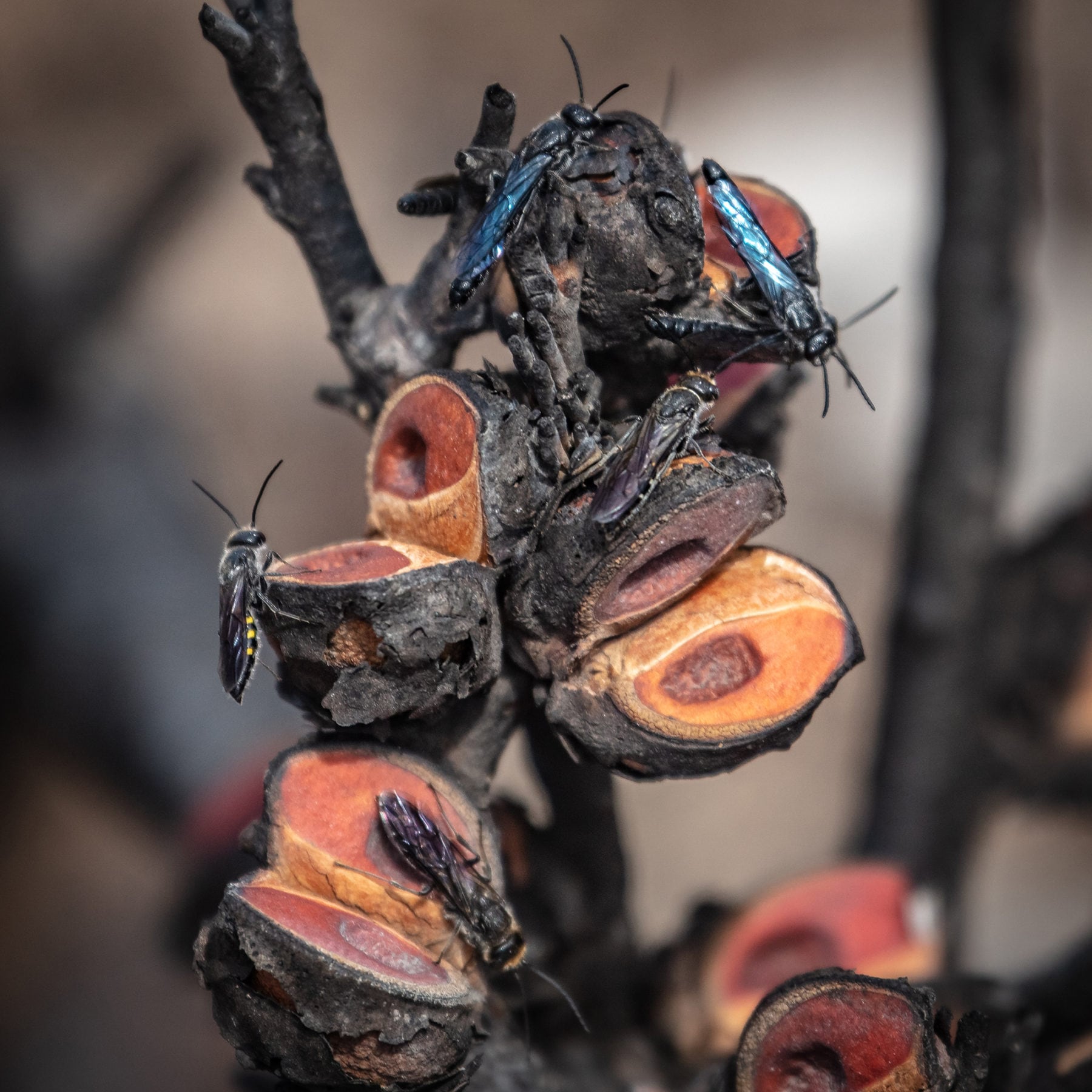
Up top, animal scats were littered across the surface from where roos, wallabies and birds had frantically sought shelter among the monoliths as the inferno engulfed the coast. Yet nearby there were signs of life: scrubwrens chattering in the burnt-out mallee skeletons with fresh tufts of red growth sprouting from their base.
On the way back from the coast we paused atop Bunker Hill. A gusty breeze was blowing spumes of powdery white ash across the road. As we gazed south, the landscape was more like snow drifts on the Bogong High Plains than the Flinders Chase we knew and loved.
But here too in the distance there were faint hints of renewal; ancient grass trees standing shoulder to shoulder – iconic survivors giving the next miracle a nudge with a spurt of green growth.
